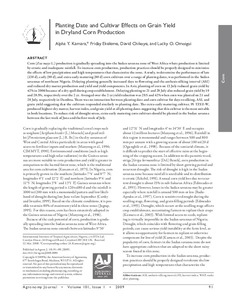| dc.contributor.author | Kamara, A.Y. |
| dc.contributor.author | Ekeleme, F. |
| dc.contributor.author | Chikoye, D. |
| dc.contributor.author | Omoigui, L.O. |
| dc.date.accessioned | 2019-12-04T11:13:53Z |
| dc.date.available | 2019-12-04T11:13:53Z |
| dc.date.issued | 2009 |
| dc.identifier.citation | Kamara, A.Y., Ekeleme, F., Chikoye, D. & Omoigui, L.O. (2009). Planting date and cultivar effects on grain yield in dryland corn production. Agronomy Journal, 101(1), 91-98. |
| dc.identifier.issn | 0002-1962 |
| dc.identifier.uri | https://hdl.handle.net/20.500.12478/2528 |
| dc.description.abstract | Corn (Zea mays L.) production is gradually spreading into the Sudan savanna zone of West Africa where production is limited by erratic and inadequate rainfall. To increase corn production, production practices should be properly designed to minimize the eff ects of low precipitation and high temperatures that characterize the zone. A study, to determine the performance of late (120 d), early (90 d), and extra-early maturing (80 d) corn cultivars over a range of planting dates, was performed in the Sudan savannas of northeast Nigeria. Delaying planting generally increased days to fl owering and the anthesis-silking interval (ASI) and reduced dry matter production and yield and yield components. In Azir, planting of corn on 13 July reduced grain yield by 42% in 2006 because of a dry spell during crop establishment. Delaying planting to 21 and 28 July also reduced grain yield by 19 and 28.5%, respectively over the 2 yr. Averaged over the 2-yr yield reduction was 29.5 and 42% when corn was planted on 21 and 28 July, respectively in Damboa. Th ere was no interaction between planting date and corn cultivar for days to silking, ASI, and grain yield suggesting that the cultivars responded similarly to planting date. Th e extra-early maturing cultivar, 95 TZEE-W, produced highest dry matter, harvest index, and grain yield at all planting dates suggesting that this cultivar is the most suitable in both locations. To reduce risk of drought stress, extra-early maturing corn cultivars should be planted in the Sudan savannabetween the last week of June and the fi rst week of July. |
| dc.description.sponsorship | Canadian International Development Agency |
| dc.format.extent | 91-98 |
| dc.language.iso | en |
| dc.subject | Planting Date |
| dc.subject | Corn Cultivar |
| dc.subject | Sudan Savanna |
| dc.subject | Corn Production |
| dc.subject | Drought |
| dc.subject | Fertilizers |
| dc.subject | Seedling Stage |
| dc.subject | Extra-Early Maturing |
| dc.title | Planting date and cultivar effects on grain yield in dryland corn production |
| dc.type | Journal Article |
| dc.description.version | Peer Review |
| cg.contributor.affiliation | International Institute of Tropical Agriculture |
| cg.coverage.region | Africa |
| cg.coverage.region | West Africa |
| cg.coverage.country | Nigeria |
| cg.isijournal | ISI Journal |
| cg.authorship.types | CGIAR single centre |
| cg.iitasubject | Maize |
| cg.iitasubject | Farm Management |
| cg.iitasubject | Grain Legumes |
| cg.iitasubject | Food Security |
| cg.iitasubject | Pests Of Plants |
| cg.iitasubject | Plant Diseases |
| cg.iitasubject | Plant Production |
| cg.iitasubject | Smallholder Farmers |
| cg.iitasubject | Markets |
| cg.iitasubject | Nutrition |
| cg.iitasubject | Agribusiness |
| cg.journal | Agronomy Journal |
| cg.howpublished | Formally Published |
| cg.accessibilitystatus | Limited Access |
| local.dspaceid | 93279 |
| cg.identifier.doi | https://dx.doi.org/10.2134/agronj2008.0090 |

